Many pianists lived fascinating lives whose biographical details are forever fused to their legacy. Sadly, for several artists it is sometimes the circumstances around their deaths for which they are most immediately remembered. One such case is the remarkable pianist Simon Barere, who died partway through a performance of Grieg’s Piano Concerto at Carnegie Hall on April 2, 1951, aged only 54.
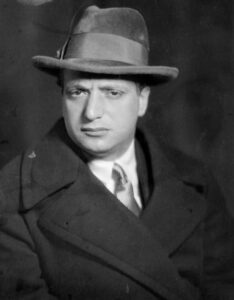
I first heard of Barere from my high school physics teacher, who used to assign a problem for the class to solve and then chat with me while I stood at his desk, telling me about which pianists I should listen to and why. It was he who told me about Barere’s tragic death and that I needed to hear his Don Juan Fantasy – a work I had not yet encountered. It wasn’t long before I found a few of Barere’s LPs in the second-hand shops: one of his Remington LPs and a Turnabout Vox vinyl with his Liszt Sonata from Carnegie Hall. Although I would have to wait before I would get his Don Juan Fantasy, I could tell right away that this was a supremely powerful pianist, with technique to burn but also more than just fingers.
A year or two later, I would go to the McGill University Library (I wasn’t a student there but was able to get in) and go through their amazing collection of 78s, with a listening station that included a turntable with a fantastic pickup that fit the grooves of these old shellac discs perfectly. While recording cassettes using the connected player, if you timed the lift of the pause button well, the machine would somehow do a perfect crossfade to join sides of the records (this could be considered my early DJ training). They had an impressive array of piano recordings, among them Barere’s HMV disc of Balakirev’s Islamey (another work new to me). I was able to effect a flawless transfer and listened over and over to the cassette – the playing blew my mind.
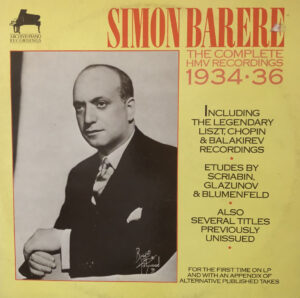
I had visited the UK in the summer of 1987 and seen an LP release of Barere’s 1930s HMV recordings (including that Islamey) but they were priced out of my student-budget range (as were most things in England) so I hadn’t purchased it. Little did I know that the producer of that ‘Archive Piano Recordings’ release would soon become a very close ally: Bryan Crimp, who would rename the label Appian Publications & Recordings (APR, as it is currently known), who over the course of the coming years provided tremendous support to my Lipatti research. Soon after our correspondence began in 1989, he released recordings of Barere Live at Carnegie Hall, which I ordered (along with those HMV recordings) and listened to voraciously. I was hooked.
It appears that Barere’s son was making recordings of his father’s annual Carnegie Hall recitals, which the pianist paid for himself (the real way to Carnegie Hall isn’t just practice, it’s an open chequebook). While a few of these had been issued on LP (such as that terrific Liszt Sonata), the vast majority remained unheard until APR got involved around 1990. Hearing Barere in a vaster array of repertoire than he recorded commercially – and in live performance – one can appreciate a good deal more of his artistry. Barere’s playing was greeted by rapturous ovations, but his career sadly had long gaps of inactivity.
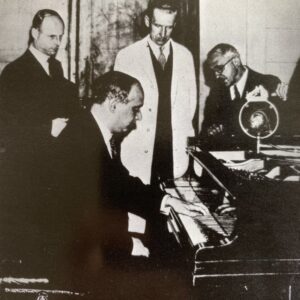
It is almost inconceivable to us that a pianist of such astounding talent should have had such a hard time making a career but sadly that is the case. Born in Odessa on September 1, 1896, Barere was recognized for his brilliance by the composer Glazunov, who reportedly had him play for two great teachers – Anna Essipova and Isabella Vengerova. The colourful tale states that things got quite heated between the two ladies due to their profound desire to teach the young musician. Essipova had won that feud but upon her death in 1914 Barere would train with pianist-composer Felix Blumenfeld (whose other pupils included Horowitz, Neuhaus, and Grinberg). Glazunov – who said that “Barere is an Anton Rubinstein in one hand and a Liszt in the other” – was a great support to the young pianist during his seven years at the St. Petersburg Imperial Conservatory, making it possible to sidestep limitations that his Jewish roots might have caused and also helping him avoid mandatory military conscription.
In January 1934 he caused such a sensation with his Aeolian Hall debut in London that he was immediately invited to EMI’s studios to begin a series of recordings under the watchful eye and ear of legendary producer Fred Gaisberg that would span two years. We can see the pianist, producer, and engineers together in this remarkable photograph of the pianist in the studio, preparing to record his stunning account of Blumenfeld’s Etude for Left Hand, one of the gems of his discography.
An invitation by the Baldwin piano makers would take him to the US, where he would settle after his great success at his Carnegie Hall debut in 1936. The war would not make things easy and although he lived in a musically rich culture, Barere’s career did not fully take off (indeed, despite having been brought to the country by a piano manufacturer, Barere never owned a piano of his own). Things started to improve towards the end of the 1940s, including an Australiasian tour in 1947 (there’s a New Zealand radio interview and he visited Jascha Spivakovsky’s home in Melbourne and signed the piano there), but this kind of international success was rare.
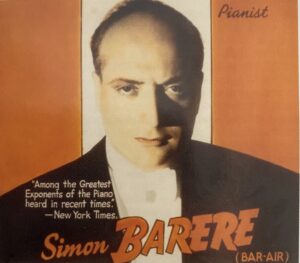
Barere seems to have had few opportunities to play with orchestra (although a few live recordings of these rare appearances exist) and it was sadly during one of these few occasions that he perished: a performance of the Grieg Concerto in A Minor with Eugene Ormandy conducting the Philadelphia Orchestra at Carnegie Hall on April 2, 1951. It has been said that on the day of the concert he had been rehearsing with Guiomar Novaes (who was playing the orchestral part) and complained about not feeling well; he debated whether he should cancel, but Novaes convinced him to play, saying that it could be the break that he wanted and that he needed the income. Alas, partway through the first movement at the concert, he suffered a cerebral hemorrhage and collapsed on stage. Novaes never forgave herself, for decades carrying the guilt for having urged the pianist to keep this engagement.
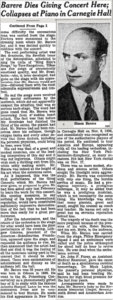
Critic Olin Downes was at the concert and described what transpired: “Mr Barere seemed to be in top form. His entrance solo was brilliantly delivered. But presently this writer was puzzled by the pace of his performance, which seemed excessively fast. Then comes the passage after the violin-cellos have announced the second theme of developments discoursed between the piano and the orchestra. A moment later it seemed as if Mr Barere were bending over to one side, listening with special attention to the instruments as he matched his tone with theirs. In another moment his left hand fell from the keyboard and in another second he fell senseless from the stool to the floor. The orchestra stopped in consternation, someone shouted from the stage for a doctor, and with some difficulty the unconscious man was carried from the stage.” An intermission was called while they attended to the pianist, but Barere died backstage. The audience was called back in and told that the rest of the concert was canceled; the Nielsen 5th Symphony was to be featured in the second half and they rescheduled it for a month later. (Another detail: apparently, Barere’s last words to the conductor were,”Mr. Ormandy, this is the first time that we are playing together. I hope it won’t be the last.”)
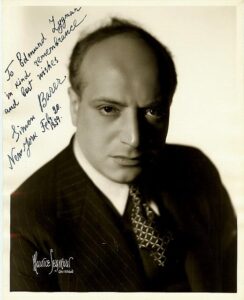 While the nature of Barere’s premature passing is forever linked to his name, it is his artistry that should be front and foremost. The fact that he had such an astounding facility at the keyboard has led to his being dismissed as ’empty’ and ‘just fingers’. The fact is he could indeed play pretty much everything faster than anyone else, and in a few works he got ahead of himself and the results are not terrific (the Schumann Toccata, for example – Horowitz asked him why he played it so quickly, to which Barere responded, “I can play it even faster.”) But listening to the bulk of his recordings one is aware of mastery that extends far beyond speed and agility. His tonal colours were exquisite and his dynamic gradations as precise as his fingerwork, while his lyrical phrasing was marvellously refined and beautifully timed. While a good deal of his studio repertoire consisted of more impressive showpieces, there are works that demonstrate his astounding sensitivity, such as the Liszt Sonetto del Petrarca No.104 and the Blumenfeld Etude for Left Hand.
While the nature of Barere’s premature passing is forever linked to his name, it is his artistry that should be front and foremost. The fact that he had such an astounding facility at the keyboard has led to his being dismissed as ’empty’ and ‘just fingers’. The fact is he could indeed play pretty much everything faster than anyone else, and in a few works he got ahead of himself and the results are not terrific (the Schumann Toccata, for example – Horowitz asked him why he played it so quickly, to which Barere responded, “I can play it even faster.”) But listening to the bulk of his recordings one is aware of mastery that extends far beyond speed and agility. His tonal colours were exquisite and his dynamic gradations as precise as his fingerwork, while his lyrical phrasing was marvellously refined and beautifully timed. While a good deal of his studio repertoire consisted of more impressive showpieces, there are works that demonstrate his astounding sensitivity, such as the Liszt Sonetto del Petrarca No.104 and the Blumenfeld Etude for Left Hand.
In honour of the anniversary of Barere’s tragic death, a selection of recordings that demonstrate his remarkable artistry – not comprehensive, of course (for the bulk of his recorded output, investigate APR’s release of his HMV and Carnegie Hall performances), but a worthy tribute to this incredible pianist.
First off is that Don Juan Fantasy that my physics teacher had spoken of so highly, with agility that seems to defy the laws of science. This performance is notable not only for its stunning pyrotechnics but also for the lovely singing lines and attentive voicing in lyrical sections, as well as marvellous rubato and dramatic climaxes. Most certainly, when it comes to passages requiring dexterity, Barere certainly takes things to another level, with the most dazzling runs, filigree fingerwork, and towering octaves, all accomplished, it should be noted, with a clear, full-bodied sonority (even in the loudest fortissimo, his tone doesn’t ‘crack’). Miraculous!
Barere’s October 10, 1935 account of Chopin’s Scherzo No.3 in C-Sharp Minor is my favourite interpretation of the work and one of his finest recorded performances. Certainly thrilling pyrotechnics are in full abundance, but it is his delivery of the opening sequence that is most arresting to me, so beautifully conceived with creative timing telling a story with the repeated figurations. Barere’s light octaves are attentive to voicing, the middle section is lyrically presented with sumptuous tone and masterful pedalling, and his proportioned rubato is beautifully coordinated with his elegant phrasing.
Barere’s account of Balakirev’s knuckle-busting Islamey referred to above is as legendary as his Don Juan Fantasy. He plays at a breakneck pace well beyond what most virtuosos can manage, yet with absolute clarity (something his son said he did without even trying). Despite the extreme speed, he has a remarkably light touch and always plays a wonderful singing tone. I’ve often said that if a pianist can play quickly but not with beautiful tone, they actually don’t have good technique, that it is dexterity together with beautiful tone production together are a sign of good technique. As with the previous recordings, as thrilling as his virtuosity is, the lyrical middle section – with a beautifully formed melodic line, elegantly shaped phrasing, and lush timing – is clear evidence that he was not ‘just fingers.’
Barere’s October 2, 1935 HMV reading of his former teacher Blumenfeld’s Etude for Left Hand is thoroughly remarkable in many ways: not only is the pianist able to navigate the keyboard at a tempo that makes it all the more challenging to believe that he is playing with one hand (and he certainly was – there’s also a live recording of him playing this at the same tempo), but he does so while voicing with incredible consistency and poetry, with a gorgeous burnished sonority, marvellous pedal effects, and lyrical phrasing. Astonishingly beautiful!
Chopin’s Andante Spianato and Grande Polonaise Op.22 is a perfect vehicle for Barere’s sensitive musicianship: this February 7, 1949 Carnegie Hall traversal reveals fluid phrasing, magnificent timing, gorgeous colours, and refined nuancing – the gorgeous glow in the opening section, with that soaring burnished line, is just magical.
One of the highlights of Barere’s discography is his thrilling account of Liszt’s Sonata in B Minor, recorded at his November 11, 1947 Carnegie Hall recital, one of the concert performances that was issued on LP soon after he died. He plays here with a varied tonal palette and seemingly effortless facility, his dramatic gestures and sensitive nuances serving his expansive vision of this titanic work. The grand recitativo delivery of the main theme in the opening section is extremely effective and in wonderful contrast to the fleetness of the section that immediately follows. A mesmerizing performance!
And this is quite a treasure: a January 31, 1949 home recording of Barere practicing a number of compositions. We hear the great Russian pianist playing (at times while speaking and singing!) excerpts of the Liszt First Piano Concerto, Gounod-Liszt Faust Waltz, Scriabin Etude Op.42 No.3 (a work of which no other recording by Barere is known to exist), Chopin Etude Op. 10 No. 5 and the Andante Spianato & Grande Polonaise. At the beginning of the clip, I thought for a moment it was Art Tatum playing before I was able to recognize Liszt’s writing! The lush phrasing of some lyrical excerpts from the Faust Waltz demonstrates his sensitivity and refined nuancing. I’m not sure of the provenance of this recording but it appears to be a wire recording of some people listening to the original private disc (we can hear them give their assessment of the playing after Barere finishes playing and refer to the wire recording). Fascinating stuff!
One of his few American performances with orchestra was a Carnegie Hall reading of Liszt’s Piano Concerto No.1 with David Brockman conducting New York Philharmonic Symphony Orchestra. Barere’s son Boris recalls that this concert took place without a rehearsal: the conductor went over to Barere’s apartment, they talked it over, and then they played the concert. When Barere heard the private discs his son had recorded, the self-deprecating pianist listened to it and said, “You know, I think the best part of the whole concerto is the applause…” The reading is a pretty wild one, but despite the tremendous speed – just under 16 minutes! – there is plenty of poetry at the right times.
There is only one other concerto of which we have a recording of Barere: Rachmaninoff’s Second Concerto, another reading that features his deeply emotive playing. In addition to his lovely singing tone (appreciable despite the amateur recording), Barere plays with an individual rubato, wonderfully highlighted voices, and beautifully shaped phrasing. The exact date of the recording is unknown, though Barere’s son believed that this was a 1944 performance.
After Barere made his 1934-36 series of discs for HMV, he produced no more studio recordings until a session for the American label Remington 15 years later, in the month prior to his death. The label would issue these performances, as well as some of his Carnegie Hall recordings, soon after he died. These final recordings are just as staggering as the earlier ones, with rapid-fire fingerwork that needs to be heard to be believed but also a wonderful sonority throughout. Here in one clip is the sum total of those studio performances, a matter of weeks before his untimely passing.
While it is impossible for Barere’s sad and shocking death not to be part of how he is remembered, it is to be hoped that the incredible richness of recordings now available – a good deal more than was ever the case in the LP era – will allow the pianist’s playing to stand more prominently, and not for the superficial perception of his astounding dexterity (which admittedly in a few cases got the better of him) but for the full power of his music-making.